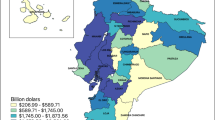Abstract
As economic losses brought about by natural disasters mount, assessing the economic impact of a possible future natural disaster is becoming increasingly important. A computable general equilibrium (CGE) model and an input-output (I-O) model are strong candidates for performing such an assessment. Even though a CGE model is more comprehensive and flexible than an I-O model, the CGE approach is often subject to criticism because key parameters are often not appropriately estimated. The purpose of this study is to calibrate two sets of key substitution parameters: the elasticity of substitution between labor and capital services and the elasticity of substitution among like goods of different origins, using a monthly, recursive, dynamic CGE model. For the calibration, this study employs a heuristic method, in which the model’s substitution parameters are adjusted to reproduce actual production losses from the 2011 Great East Japan Earthquake. In addition, we test whether the CGE model can reproduce the actual economic recovery from this earthquake. Overall, we find that our model does reproduce the disaster’s economic dynamics of recovery, as well as its short-term economic impact.









Similar content being viewed by others
References
Aguiar A, Narayanan B, McDougall R (2016) An overview of the GTAP 9 Data Base. J Global Econ Anal 1(1):181–208. https://doi.org/10.21642/JGEA.010103AF
Alaouze CM (1977) Estimates of the elasticity of substitution between imported and domestically produced goods classified at the input-output level of aggregation. IMPACT Working Paper O-13. Monash University IMPACT Project, Melbourne
Alaouze CM, Marsden JS, Zeitsch J (1977) Estimates of the Elasticity of Substitution between Imported and Domestically Produced Commodities at Four digit ASIC Level. IMPACT Working Paper O-11
Armington PS (1969) A theory of demand for products distinguished by place of production. Int Monet Fund S Pap 16:179–201. https://doi.org/10.2307/3866403
Berrittella M, Hoekstra AY, Rehdanz K, Roson R, Tol RSJ (2007) The economic impact of restricted water supply: a computable general equilibrium analysis. Water Res 41(8):1799–1813. https://doi.org/10.1016/j.watres.2007.01.010
Boisvert R (1992) Indirect losses from a catastrophic earthquake and the local, regional, and national interest. In: Federal Emergency Management Agency (ed) Indirect economic consequences of a catastrophic earthquake. Federal Emergency Management Agency, National Earthquake Hazard Reduction Program, Washington DC, pp 207–265
Boyd R, Ibarraran ME (2009) Extreme climate events and adaptation: an exploratory analysis of drought in Mexico. Environ Dev Econ 14:371–395. https://doi.org/10.1017/S1355770X08004956
Brookshire DS, McKee M (1992) Other indirect costs and losses from earthquakes: issues and estimation. In: Federal Emergency Management Agency (ed) Indirect economic consequences of a catastrophic earthquake. Federal Emergency Management Agency, National Earthquake Hazard Reduction Program, Washington DC, pp 267–325
Fischer C, Fox AK (2007) Output-based allocation of emission permits for mitigating tax and trade interactions. Land Econ 83:575–599. https://doi.org/10.3368/le.83.4.575
Gallaway MP, McDaniel CA, Rivera SA (2003) Short-run and long-run industry- level estimates of U.S. Armington elasticities. North American J Econ Financ 14(1):49–68
Gordon P, Richardson HW, Davis B (1998) Transport-related impacts of the Northridge earthquake. J Transp Stat 1:21–36
Haimes YY, Jiang P (2001) Leontief-based model of risk in complex interconnected infrastructures. J Infrastruct Syst 7(1):1–12. https://doi.org/10.1061/(ASCE)1076-0342(2001)7:1(1)
Hallegatte S (2008) An adaptive regional input-output model and its application to the assessment of the economic cost of Katrina. Risk Anal 28:779–799. https://doi.org/10.1111/j.1539-6924.2008.01046.x
Hallegatte S, Przyluski V (2010) The economics of natural disasters: concepts and methods. World Bank Policy Research Working Paper No. 5507. The World Bank, Washington D.C.
Horridge M, Madden J, Wittwer G (2005) The impact of the 2002–2003 drought on Australia. J Policy Model 27:285–308. https://doi.org/10.1016/j.jpolmod.2005.01.008
Miyazawa K (1976) Input-output analysis and the structure of income distribution. Springer, Berlin
Munro A, Managi S (2017) Going back: radiation and intentions to return amongst households evacuated after the great Tohoku earthquake. Econ Disaster Climate Change 1(1):77–93
Nakano K, Kajitani Y, Tatano H (2013) Functional fragility curves for a production facility of industrial sectors in case of earthquake disaster. Doboku Gakkai Ronbunshu A1 69(1):57–68 (in Japanese)
Okuyama Y (2004) Modeling spatial economic impacts of an earthquake: input-output approaches. Disaster Prev Manag: Int J 13:297–306. https://doi.org/10.1108/09653560410556519
Okuyama Y (2015) How shaky was the regional economy after the 1995 Kobe earthquake? A multiplicative decomposition analysis of disaster impact. Ann Reg Sci 55:289–312. https://doi.org/10.1007/s00168-015-0691-z
Okuyama Y, Santos JR (2014) Disaster impact and input–output analysis. Econ Syst Res 26:1–12. https://doi.org/10.1080/09535314.2013.871505
Ouyang M (2014) Review on modeling and simulation of interdependent critical infrastructure systems. Reliab Eng Syst Saf 121:43–60. https://doi.org/10.1016/j.ress.2013.06.040
Pauw K, Thurlow J, van Seventer, D (2010) Droughts and floods in Malawi: assessing the economywide effects. International Food Policy Research Institute (IFPRI) Discussion Paper 00962. International Food Policy Research Institute. Washington DC
Rose A (2004) Economic principles, issues, and research priorities in hazard loss estimation. In: Okuyama Y, Chang SE (eds) Modeling spatial and economic impacts of disasters. Springer, Berlin Heidelberg, pp 13–36
Rose A, Guha GS (2004) Computable general equilibrium modeling of electric utility lifeline losses from earthquakes. In: Okuyama Y, Chang SE (eds) Modeling the spatial economic impacts of disasters. Springer, Berlin Heidelberg, pp 119–141
Rose A, Liao SY (2005) Modeling regional economic resilience to disasters: a computable general equilibrium analysis of water service disruptions. J Reg Sci 45:75–112. https://doi.org/10.1111/j.0022-4146.2005.00365.x
Wittwer G, Griffith M (2010) Closing the factory doors until better times: CGE modelling of drought using a theory of excess capacity. Paper presented at the GTAP 13th Annual Conference, Penang, Malaysia, June 9–11, 2010
Author information
Authors and Affiliations
Corresponding author
Rights and permissions
About this article
Cite this article
Yamazaki, M., Koike, A. & Sone, Y. A Heuristic Approach to the Estimation of Key Parameters for a Monthly, Recursive, Dynamic CGE Model. EconDisCliCha 2, 283–301 (2018). https://doi.org/10.1007/s41885-018-0027-4
Received:
Accepted:
Published:
Issue Date:
DOI: https://doi.org/10.1007/s41885-018-0027-4




